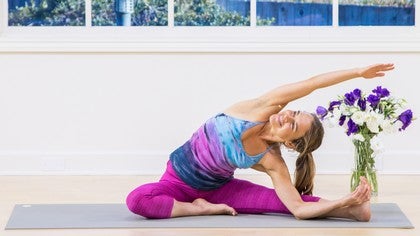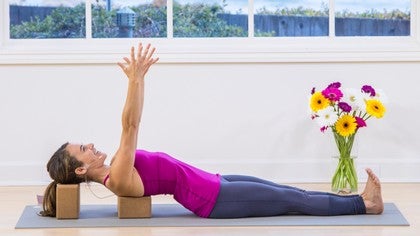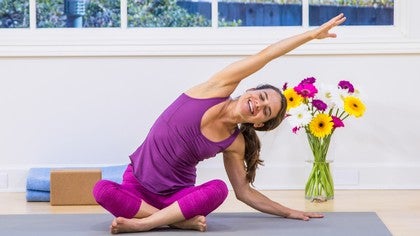Description
About This Video
Transcript
Read Full Transcript
(water swooshing) Welcome back. Thank you for being here. So, in this practice, we're gonna sequence towards headstand, Sirsasana. And we're gonna find elements of it. So, if you don't have a headstand practice.
I know for me, I practiced Yoga for many years before I actually I went up into headstand, and it's just been in the last year or so, that I fell in love with it. So, this will take you through steps, and we'll find elements to help us experience headstand without necessarily going up into it. So, for this practice, you'll need two blocks. I have cork blocks but you can use foam, whatever you have at home. And then, if you have a strap, that'll come in handy.
So, we'll first setup with impressing the heart. And this is a wonderful opening just to begin to experience this quality of opening through the front of the body. So, to find a bit more space through the collar bones, the heart, the rib cage, and the shoulders. We'll also observe and work with the breath. And in this practice, we won't be doing any sun salutations, Chaturanga, Dandasana, any thing like that.
Okay, so setup with one block. This will support the base of your skull. The occiput at the highest setting. And then, the second block at the lowest setting which will support your shoulder blades. And I'll demonstrate how to get into it.
So, come on to your sit bones, and then from here, you're going to use your abdominals to come onto the block. And then, bringing the other block right at the base of the skull. And so, it's not a back bend. See where the block is in my back, but it's higher. So, it's really supporting my shoulder blades, and you can play with it and find a sweet spot for you.
Like for me, it's right about here. And then, I'll take the edge of the block, and I like to wedge it right through the base of the skull, and then, soften the chin towards the chest. Good. And then releasing the arms down the back. So, shoulder blades sliding the back.
Again, this quality of lengthening through the base of the skull. Bring the soles of the feet slightly wider than the hips and let the knees rest together, just to begin to drop in and settle into the shape. (breathing) The softening release down through the lower back, down the sacrum and the tailbone. And then, begin to allow the palms to open, so again, this quality of opening through the shoulders. A bit of an external rotation.
Feel that opening up through the arms and shoulders softening down the back. Palms open and receptive. And then, allow the body, allow your body to begin to receive the support beneath it. So, initially there's some effort to find a bit more ease. An effort towards (breathing) receiving.
And as the back body softens, to receive the support, it can encourage and allow the front body to soften and open a bit more. Nice. And as you settle into the blocks, begin to bring some attention towards your breath. Notice the quality of your breath. And naturally as we bring some attention towards our breath, the quality will begin to change.
There's a deepening of the breath, our relationship with the breath. What would it feel like to allow the breath to be a bit more smooth and steady, full, and wide? And as you tune towards the breath, continue to observe and notice where you can soften any tension, and releasing towards the support. Perhaps, feeling the arms a bit heavier, widening through the collar bones, softening the rib cage. Really allowing the rib cage to settle.
You might keep your legs where they are to support your lower back, right. You might choose to extend one leg at a time. (breathing) Still tuning towards your breath. And now, from here, I'll invite you to lower the block to the second setting. And as you lower it to the second setting, placing it towards the top part of the skull, so it's not up around the neck, like this.
But it's back supporting your head. Allowing the shoulders to draw down the back. And you might reach the arms down to the side. You might find a variation of cactus, softening the elbows a bit. Palms open.
There's a nice wide opening through the front body. Nice, expansive stretch through the shoulders. (breathing) Just a few more moments here. Again, settling and receiving support. You might even imagine the body more like water.
Washing over the blocks. Nice. Good. Okay, and then reach the arms along the sides. And then, bring the feet in, like as if you were in Tadasana. And we'll begin to find some action through the legs.
So, flexing the feet spreading the toes. And now, right here if the lower back arched like this, see what it feels like to draw the navel, the belly button towards the spine a bit. And then, letting the tailbone descend towards the heels. Right, instead of this arching, this action of (breathing) drawing the tailbone towards the heels. And then, let the palms turn in towards the body.
So, I'm drawing the shoulder blades down the back. From here, we'll inhale, reach the arms up towards the sky. And then, soften the shoulders down the back. Feel your inhale. And as you see exhale, extend the arms overheard, so there's a nice extension reaching from the heels through the thumbs.
Again, let the back of the neck stay nice and long as you reach and lengthen. Again, draw the tailbone towards the heels. Soften through the back of the heart. As you inhale, reach the arms towards the sky, and then, exhale release the arms down. We do that two more times.
As you're ready, inhale, reach the arms up, and then draw the should blades down the back, and in. Good. Feel your inhale. And as you exhale, extend through the heels, reach though the spine, extend through your thumbs. Back of the neck is lengthening, beautiful. From here, breathe into the rib cage.
(breathing) Nice, on your next inhale, reach the arms up to the sky. Exhale, release the arms down. One more time. Inhale, reach the arms up, soften the shoulders down the back, inhale, exhale, arms overhead. Lengthening out of the pelvis a bit.
Evenly through the back body and the front body, breathe wide. (breathing) Good, as you inhale, reach the arms up, and as you exhale, lower the arms. Nice. Relax the effort through the legs and the arms. Take an inhale, exhale, and release.
From here, bend the knees. Now, to come off the support, reach the right arm overhead. Roll off the blocks to your right side. Take a moment to pause on your side. Okay, and then we're gonna push the blocks off to the side and roll onto our back.
So, for me, I'm gonna press up for a moment. Push the blocks to the side. And then come on to my back. Nice. Now, as you come to your back, extend through the legs, and extend through the arms.
And take a moment here to observe the effects. Notice any results. Just observe how you feel. (breathing) Good. From here hug your knees into your chest.
And then, to find a bit more for the hamstrings, you might have a block nearby, or rather a strap nearby. And then, keep your right knee into your chest. Let the left foot come down. Extend up through the right leg. Now, here you might bring your strap around the bottom of your foot.
Or extend your hand towards your big toe. You might keep that left foot grounded on the floor to support your lower back, or extend through your left leg, and flex the foot, reach through the heel. Now, if grouping the toe causes your shoulder to lift, your jaw to clinch and your eyes to feel tight, then I would suggest using a strap here. Now, notice again, the quality of your breath. You might bring your left hand to ground the left hip.
I'm stretching the hamstrings, breathing. (breathing) And then, opening up to the right for a few breaths, grounding through that left hip. Opening up to the right. And breathing. And a gaze might be over your left shoulder, or simply where it feels comfortable straight ahead.
(breathing) Ground through the left side on your inhale. Come back up to center. Now, from here, begin to engage the abdominals a bit. And then, you might grab a hold of your strap or your foot, and then begin to get round, use the belly, curl up. And bring the forehead towards the shin, navel towards the spine.
And then exhale, release, stabilize the core and the hips, extend through the heel, lower all the way down. Just take a moment to again, check in with your body. Notice. (breathing) Hug your knees into your chest again. And then, second side, bring the right foot to the floor.
Left knee towards the chest. Extend the left leg towards the sky. Then, you might bring the strap around the bottom of your foot, or reach the fingers around the toe. Keeping the right foot grounded to support the back, or extending the right leg, and flexing the foot. With that right hand grounding through the right side of it.
So, from here, finding your breath again. (breathing) And active through that right leg as you extend. Soften through the face. And then grounding through that right hip. Opening up to the left for a few breaths.
Notice how that right hip wants to come up. Can you feel a bit more grounded and stable through the right side body? And then breath into where you feel the sensation, the stretch. (breathing) On your inhale, come back into center. And the hands might be on the strap, or you might bring the hands around the foot, engaging the abdominals.
Inhale, and as you exhale, begin to curl up. Bring the forehead towards the shin, navel towards the spine. And then, slowly releasing down. If you have a strap there, remove the strap, flex the foot, and then stabilize the hip and the core as you extend and lower all the way here, reaching. Nice, take a moment, relax the effort.
Allow for a clearing breath. Inhale. And exhale. Release. (breathing) Beautiful.
Hug your knees into your chest. And then from here, roll to your side. Press your way up with the hands, and then, find your way onto all fours. Coming into table top. So, coming on to your hands and knees.
Spread the fingers wide apart in table top. And we'll take a few rounds of cat cow breathing in and as you exhale, get round, and curl the tailbone under, release the head. Inhale, arch the body, draw the shoulder blades towards each other, wide through the collar bones. Exhale, get round. One more time like that.
Inhale to arch. And exhale to curl. And press back, child's pose for a few breaths. As you come into child's pose, bring your awareness towards the back of the heart, right where the shoulder blades were resting on your block. With your awareness here, breath into the back body, so breathing into the space, between the shoulder blades, back at the heart.
Softening through the jaw and the belly. (breathing) Good, from here, inhale, come back, and all fours onto table top. And from here, we'll lower down on to the belly, and then come into cobra, softening the shoulders down the back, inhale, and lift. Exhale and release. Tuck the toes under, and then press back.
Come into child's pose. So, we'll find five rounds like that, moving at your own pace, finding your own rhythm. Inhale onto all fours. Exhale, lower down, soften the shoulders down the back, inhale, peel up to cobra. Exhale, release, press back into child's.
As you press back, get round. Nice, inhale, round up. Exhale, elbows in. Soften the shoulders, inhale, rise up, cobra. Exhale, release.
Tuck the toes, get round, press back to child's pose. Inhale, round forward, over the wrists, lower down. Draw the shoulders down the back, elbows, press up, cobra. Exhale, release, get round. Press back.
Nice, let's do that one more time. Inhale, round forward. Lower yourself down, draw the shoulders down the back. Inhale with the heart. Exhale, release.
Tuck the toes, get round. Press back, child's pose, release the arms. Bring the hands underneath the shoulders, chin into the chest. And then, slowly roll on up. Nice.
Now, from here, take one of your blocks. Bring your block out in front of you. And we're looking for this action through the shoulders and through the lats. So, I'll demonstrate, bringing the hands around the block, as if we're going into like dolphin plank, pressing the hands into the blocks, drawing the shoulders down the back, okay. And then, from here, begin to draw the forehead toward the floor.
You might draw your knees back underneath your hips. Now, press the hands into the block. That will activate the shoulders, shoulder blades. Nice, so you might continue to draw your hips back a bit more, pressing the hands into the block, breathing. And the back of the neck is long and relaxed here.
Nice, from here, bring the palms underneath the shoulders, and then slowly roll back up. Okay, so we'll play with that towards dolphin blank, with the support of our block. Okay, so bringing the hands around the outside of the block, drawing the shoulders down the back. Pressing the hands into the block. Step one foot back, and then the other foot back.
Now, the play here is to reach back through the heels, length, and through the crown of the head, the back of the neck is soft. The legs are super active and engaged, and my belly is reaching up a bit. So, there's a lift in quality up through the belly, rather than the strapping, there's a lifting. Inhale, exhale, release the knees. And then, from here, draw the hips back.
So, again, we're finding that stretch through the shoulders a bit. (breathing) Okay, we'll find that one more time. And pressing the hands into the block, draw the shoulders down the back. The neck is soft. Extend back through one leg, tuck the toes, and then find the other leg.
Okay, so reach back through the heels, lifting up, legs are active, breathing. Take one more breath. Nice, release, draw the hips back. And then, release the arms along your sides. (breathing) Good, chin into the chest, roll up for a moment to Mudrasana.
We're gonna add on. We're gonna play with what we often times call is like a hitchhiking dolphin. So, we're finding this action and bringing the back of the hand into the block, and then pressing the back of the hand into the block, as we find that wrapping quality through the shoulders, through here. Okay, so I'll demonstrate first. And, the idea is to bring your hand right about here.
If you bring it higher in the middle, your head will hit the block. So, it won't give your head enough room. So, again pressing the back of the hand into the block, drawing the shoulder blades down the back. From here, tuck the toes under it. And you might stay right here today.
Just working this action here. You might play with tucking the toes under, lifting the hips, right, and pause here. Good, breath in. Nice. So, my head is off the floor.
The neck is relaxed. My arms are engaged, my shoulders are engaged, the back of the hands are pressing into the block for support as I lengthen the spine. And then, you might play here with walking the feet towards your head. You can bend the knees here, right. Kind of alleviate the stretch through the hamstrings, and lift though the sip bones.
So, right here, we're in an inversion. Good. As you're ready to release, walk back, bend the knees, rest in child's pose, forehead towards the floor, and then reach the arms along your sides. Take a moment to rest in child's pose. (breathing) nice.
And then, bring the hands underneath the shoulders, chin into the chest, and gently roll up, to take a moment to pause. Settle. (exhaling) Okay. So, from here, let's find a downward dog. So, spreading the fingers wide, tuck the toes under, and lift the hips, and press back into your downward dog, rooting through the hands, and then, reaching your hips.
Your sip bones away from the hands. Pressing through the outer edges of the feet. Then, you get a sense of reaching from the heart into the hands. (breathing) Nice, as you're ready, bend the knees. And then, bring your block under your sip bones, so sitting in Virasana for a moment.
And you might actually use two blocks here as you sit down. So, you might use one, or you might prefer using your second block and placing it on top. I'll just demonstrate for a slightly higher seat, which can actually feel quite nice, okay. Okay, so taking a moment to settle down here. (breathing) Feeling the sip bones ground a bit, lengthening up through the spine.
And now, here in Vajrasana, can you, or in Virasana, can you remember the feeling, of a block supporting the shoulder blades, and the base of the skull? Right, can you align a bit more with that feeling of impressing the heart? So, that widening through the base. That sort of spacious, generous quality through the heart. Yeah.
That (exhaling) letting the tailbone descend a bit, ribs soften in. From here, bring the hands, interlace the hands behind the head. And then, begin to bring the elbows towards each other. So, the elbows are towards each other, parallel, and the forearms are parallel with the ceiling. And can you get a sense here with lifting from the sip bones all the way up through the base of the skull.
Again, what might want to happen is this action. This lifting here, and the sort of compression through the low back. So, often times, in headstands, it's important to find that action. We're finding the belly, engaging the core. And then, also, making subtle adjustments with the tailbone of drawing the tailbone down towards the heels.
And then, lifting through the base of the skull. Elbows drawing towards each other, parallel with the ceiling. Take a few more moments here. Breathing. Nice, good.
Inhale, exhale, release the arms. And inhale, draw the shoulders up gently, and then exhale, and release the arms down. Okay. And then, lean forward. You might bring your block off to the side.
And now, we're gonna set up for headstand, Sirsasana. So, you might work those actions that we've been honing during this practice. You might play, if appropriate. And if you haven't gone up into headstands before, today may or may not be the day to do it. So, really listening to your body, and what's appropriate for your neck, and what feels right.
But you can find those actions without bearing any weight on your head. So, the first step is to interlace the fingers kind of softly here. And then, bring the elbows, again parallel with each other, so they're not wide like this. But we want it nice and tidy. And then, bring the back of the head to the hands.
And like right here, keep it soft through here, so, we're not squeezing the back of the head and the neck. And then, find that action of drawing the shoulders down and then, back. So, just let the shoulders drop a bit. And then, find that integrity as you draw the shoulders up and back. Nice.
Now, you might stay here and just work this action. You might play with tucking the toes under and lifting the hips, right. So, it's similar to that dolphin plank. Right, you might pause right here, and breathe. And just see what it feels like to bring some weight right into like the center, the front point of the skull.
So, if that felt comfortable, and headstand is part of your practice, you might join me, as we move towards Shirshasana, in a headstand. And if today, doesn't feel like the right day for you, you might hone in some of the other elements that we've been working through the practice. Okay, so finding the interlace through the fingers. And then, I'll just mention here. For you, you might play with kicking one leg up, and the other leg up.
For me, often times, I find that it gives me more momentum that I need and I kind of do this like, roll, fall thing. So, for me, I've been practicing and honing the pike up, so engaging the core, and I find that it gives me more stability, okay. So, that's what I'll offer. If for you today, you prefer kicking one leg up, and the other, and that feels good, try that. Okay, so interlacing the fingers.
And again, there's stops along the way. So, one suggestion is just to stay right here. And begin to play with putting weight into the center crown of the head. Again, finding that action through the shoulders, of drawing the shoulders down and away. And I mean, down like back and away.
Good, the back of the head is soft. Breathing. Nice, and then tucking the toes under. Again, you might stay right here. Right, you might stay right here.
You might play with walking the feel a little closer and kicking one leg up, maybe the other leg. Maybe it's comfortable to play with piking up. Finding a spot to focus on. Keep that integrity through the shoulders. Reaching through the toes.
My work here is to draw the ribs in and back. Lengthen through the tailbone, breathe. Good, when you're ready to release, slowly come down. And rest in child's pose. (breathing) Nice, chin into the chest, rolling up.
Beautiful work. Come on to your belly. Okay. And now, here we're gonna find lounging Buddha and repose, and I'm gonna roll to my left side away from you so that you can see my shoulder and what I'm about to do. So, from here, I'm gonna roll onto my left side, and reach the left arm out.
Finding a reclining Buddha, and you might rest your left ear towards the shoulder, and the right hand along your side. And I forget how much I love this pose. Take a few moments here, like soak it in. Yeah, you might keep your head where it is. You might prop yourself up.
A reclining Buddha at the beach. Allowing the head to receive the support of your hand, if it's there. And then, releasing the head, and then releasing the right arm towards the sky. Finding that internal rotation. And then, bring the back of the hand.
Again for you, it might be around the sacrum, or perhaps between the shoulder blades. Again, where that block was resting, and then pressing the heart. And then, from here, I'm gonna bring my right foot to the floor, let the hip open, and then roll onto my back. So, I'm finding a nice stretch through that right shoulder. And you might bend both knees.
I'm gonna bring my left hand into heart. So, finding that nice stretch through the right shoulder, feeling the front of the heart, the back of the heart, the neck long. Nice. Okay, when you're ready to release, extend the left leg, the left arm, and then gently roll on out. Release that right arm, you might shake it out.
Come back into reclining Buddha into repose, and then, roll onto your body. We'll find that on the right side. Extend that right arm, roll onto the right side. And then, from here, the left hand might rest on the hip. Just take a moment here lounging.
(breathing) And you might prefer the right ear on the right shoulder, or find Buddha at the beach, propping your head up. Just taking a moment, again to receive the support. Again, what would it feel like to have a bit more ease in the body, and then on practice, and in our lives. Okay. Release the right ear towards the shoulder.
Reach the left arm up. Find that internal rotation. And then, again, for you, in the shoulder, on the side, you might bring the hand to the sacrum, or up the back, maybe between your shoulder blades. Bend the left knee, open the hip, and then roll onto your back. And you might stay right here and pause.
You might bring the right foot to join the left. It might feel nice to rest that right hand on the heart. Lengthen through the back of the neck. Again, letting the low back settle. (breathing) Breathe into where you feel the sensation, the stretch.
Okay, when you're ready to release, extend your right arm, extend your right leg, roll onto your right side. Come back into your Buddha, nature (laughs), release the left arm. Let it release, and just take a moment here. Again, settle back into repose. Okay, and then rolling onto your belly, and press your way up.
We'll just visit the child's pose for a moment, drawing the hips towards the heels, forehead on the floor, and then, rolling up (exhaling). And then, finding a seated position to close our practice. (breathing) Okay, settle in. And as you settle in, invite that uplifting quality through the spine, and allowing your awareness, your presence, to gently expand a bit more, brighten, inviting the mind to settle, wide and spacious through the base of the skull. When you're ready, join the hands together.
And gratitude for our practice, namaste. Thank you for joining me. Thank you, have a beautiful day, namaste.
Good Morning Yoga with Alana
Comments
You need to be a subscriber to post a comment.
Please Log In or Create an Account to start your free trial.

















